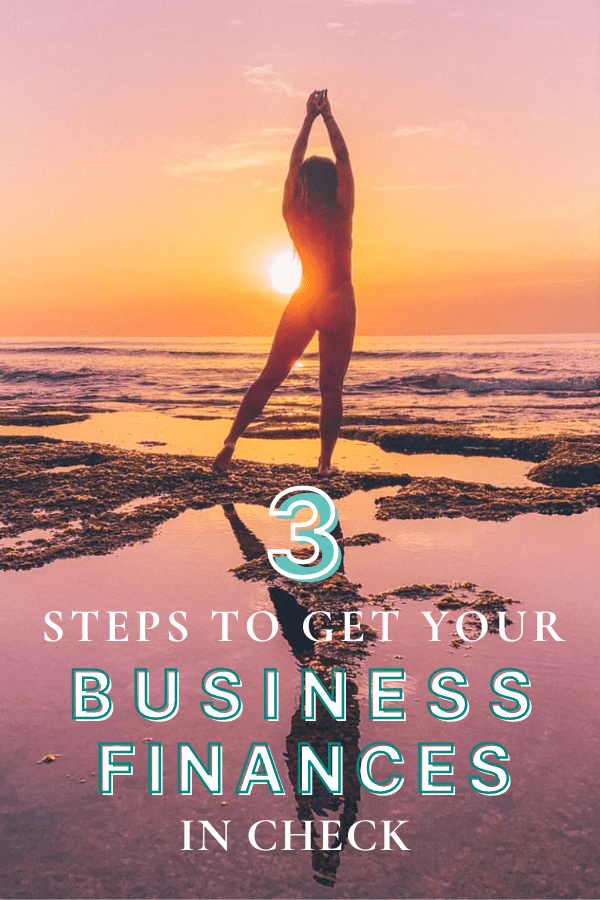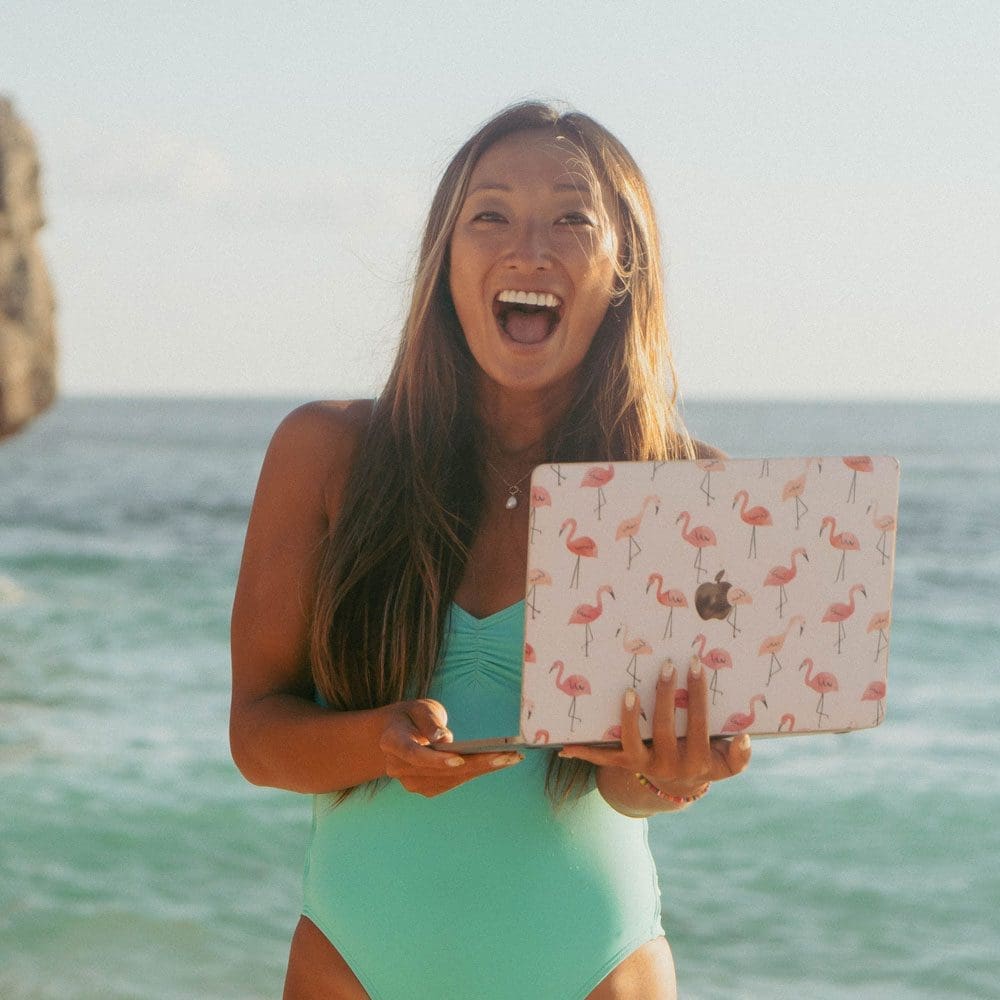Tracking your finances isn’t necessarily your first or favourite thing to think about when you’re running a business – but it is mine! So I break it down into 3 simple steps that will help you understand and improve your finances in the easiest way possible.
Quick Links
✧ Join the Digital Nomad Society for Just $7/Month
✧ Follow The Wanderlover Podcast on Instagram

Prefer to read? Here’s the blog version…
Introduction
Hi, everyone. Welcome back to The Wanderlover Podcast. I’m your host, Danielle Hu. For all of our new listeners, I am currently recording this episode from Batukaras, Indonesia, and that is where I’ve been for the past three and a half months.
Wow. Yeah, I arrived mid-June, so it’s been three and a half months! We decided we’re going to extend our stay for another two months, so we’re going to immigration sometime this week or next week, and we’re going to extend because I absolutely love it here. If, you don’t know where Batukaras is and if, you don’t know why I’m here. Check out my episode, ‘My digital nomad life in Batukaras, Indonesia’ – but long story short, perfect surf lifestyle. So it’s super chill. Love the community. Here I am meeting so many people who are just international longboarders, so surfers who travel from longboard destination to longboard destination, people from Hawaii and Morocco and France and all integrating so nicely with the local surf community.
Plus our living situation is perfect. We have a two bedroom, so I have my own office right by the beach. So yeah, that is why we are staying. And for all of you who aren’t new to the show, I have exciting updates for all of you regarding where we are going next. So in December, I am flying back to New York for the holidays to visit my friends and family. I think I’m gonna fit a trip to Miami in there to meet up with my business partner and work on some content for Onda. Gonna spend Christmas and New Year’s at home and I think in January I will be making my way back over to here, back to Batukaras/
That is actually when the season is really, really good for surfing. The plan is I am going to stay 60 days because that is the length of a tourist visa without having to go to immigration to extend it. And then at the beginning of March, Ragz and I will be flying back to New York and my best friend slash business partner is getting married in March in Mexico. So we will be making our way over to Mexico and the plan is right now to maybe stay a few months there. It’s not completely decided yet, but we will be stateside for at least the first half of 2023, or that is a plan for now.
Who knows, everything can change in an instant, and that is just the beauty of having an online business that allows you to work from anywhere. So Ragz and I have been doing this for the past few years and every time my parents ask me like, Where are you going to be in a year? What are you gonna be doing at the end of next year? I never have any idea and Ragz and I are just so used to living spontaneously, literally going wherever in the world our hearts and schedules take us. And so that is a little life update behind the scenes at the Wanderlover, something really exciting going on is I am bringing on a new assistant just to make life easier and to hand over some more admin tasks.
It’s always so exciting when you bring someone on board to your team who are equally as passionate about your company and your values as you are. So I’m really happy I found the perfect fit. We are now up to 17 members here at The Wanderlover. I might do another episode about this, how I structure my business and how it all runs. But yeah, everything is flowing really nicely. I have workflows for clients, for customers all in place, and everything just feels super structured, organized and inflow even when we are traveling and moving around all the time.
Getting your business finances in check
So on the topic of structure and management, this week’s episode is Three Steps to Get Your Business Finances in Check.
And I felt really called to record this because I’ve been getting similar questions from existing clients, new clients, and even in my dms about how business finances work. And it’s really hard to find information like everyone’s at different places in business. Some people have entire finance teams, you know, working for them, and I am specifically speaking to solo printers or new entrepreneurs who either just started or they’ve been in business for less than two years. It’s one of those things where If, you don’t take the time out to learn or seek the information. You’re probably going to give it not as much thought as needed.
So If, you are listening to this episode and you don’t have your business finances in check. By the end of this episode, you will know exactly what to do, what to execute on, and what to keep note of moving forward in your business.
So first and foremost, I want to preface that I’ve noticed a lot of people inherently having limiting beliefs around abilities to track or manage money. So if you grew up with maybe influences like parent figures or guardians who weren’t open about discussing money or they weren’t really transparent with how they managed money and they didn’t have these systems in place.
I feel like you almost develop this resistance to the numbers in your business. So it becomes one of those things that you don’t want to look at. A lot of entrepreneurs just pretend like it doesn’t exist or it’s not something that they have to implement in their workflow and that just could not be farther from the truth. I personally came from a finance background. I worked at Bank of America for a number of years. I studied finance and strategy in college, and I was always just really into numbers and spreadsheets because it really gives me an understanding of what is happening in my business. And I truly think numbers don’t lie.
Business is basically a numbers game and all about numbers. So it’s just so important that you start keeping track of your numbers, it’s going to make you a better ceo, it’s going to make you a better entrepreneur, a better strategist, you’re gonna be able to grow faster. So set the intention that you are going to learn this and execute. And we are going to do this by first shifting the narrative. So repeat after me. I am so, so excited to get my business finances in check. Okay, ready? Let’s do this.
Separate your business and personal expenses
Step number one, separate your business and personal expenses.
So how you do this is you open up a business checking account. You can do this with Chase, with Bank of America. And the biggest thing here is you don’t need to have an LLC or an EI number in order to open up a business checking If. You are a sole proprietor. You can just use your social security number and if you’re not American, I don’t know how the banking system works in other countries, but at least open up a separate account for your business income, even if that means just another simple checking account. This way you can have all of your business income through Stripe, through PayPal, through transfer wise, through Venmo, whatever come in through your business checking.
This literally takes like a day max. So if you’ve been holding off on this, really just take five minutes to apply to Open one and have that account there so you can start using it. Bonus points, If, you want to open two accounts so that one account can be for your taxes, your future self, and your next level CEO self will. Thank you for this. When it comes tax time this way, every time you make business income, you can save part of it for taxes because you’re inevitably going to be paying taxes. So while you’re at it, if you’re going to open one account, you might as well open to checking accounts, more bonus points, If, you open up a business credit card, you can then separate all of your business expenses from your personal expenses.
You can do this with a business debit card as well that you will get with your business checking, but with a credit card, you have the ability to earn points and or miles, whatever your reward system is. Personally, I use the Chase system. So I have the Chase Sapphire Reserve for my personal expenses and then the Chase Business Inc. Preferred for my business expenses. The great thing about this is every time I use one of these credit cards, aka every time I purchase something in my life, I get points, points that translate to dollars that I can redeem for flights, for travel.
And I have not paid out of pocket for a single international flight for the past few years. I think it’s like three or four years of international flights that I’ve just been able to cover fully using my points. So with the Chase system, I am able to pull together all of the points I get from my personal credit card and my business credit card and then redeem them for 1.5 times their value. It is honestly amazing, like everything that I normally spend money on rewards me back with points and with each of these credit cards you have different categories of tiers. So for Dining on the Reserve, I believe it’s like three times the number of points.
And with marketing on the business side, it’s also three times the amount of points. Don’t quote me on this, it’s all on their website, but all the major categories like dining and gas and marketing and your phone bill, all major expenses you get extra points for. So personally, this works really well for my business. It works well for a few of my clients as well, especially If. You already bank with Chase. It’s just like the natural next step. I know Amex also has their business and their personal reward system that’s equally as lucrative. For the Chase Sapphire Reserve there is a $550 annual fee. However, they give you $300 in travel credit every year, plus you get global entry and lounge access.
So you have priority paths, they have lounges around the world, so you get to enjoy lounges while you are waiting for your flights. The Chase business card has a $195 annual fee, I believe, and it has paid for itself over and over again. Do your research and find a system that works for you and put it in place. If, you would like my referral code for either of the credit cards, just CME and I can send you a signup link. If, you are based in America. I cannot advise on systems in other countries, but essentially step number one, separate your personal and business expenses.
I hope I’m not already losing some of you. I know some of you might be rolling your eyes being like, Why? Why do I have to do this? You know, why can’t I just pass everything through one account and at the end of the year I will separate my business and my personal expenses? You might be thinking you don’t even have that many business expenses, you might not have a certain level of business income that literally does not matter. The main thing to remember here is If. You treat your business as a hobby, it will pay you like a hobby, but If, you treat your business like a business, then it will pay like a business. So think about your business in a year’s time and five years time from now, are you giving it your all?
Are you treating it as a business that’s going to be able to generate income that’s gonna be able to run itself? If so, you really need the structures and foundations in place. So If, you don’t already. Let’s start separating everything this week. Chiming in here really quickly, I have a free masterclass, How to Build, a Successful Online Business that Allows You to Travel the World. This is how I operate the Wander Lover and have multiple streams of income all online over the past four years of full-time travel. In this exclusive 40 minute masterclass, you will learn how to build your online coaching creative or service based business. Choose your profitable online business idea that is unique and aligned without getting stuck in paralysis by analysis.
Start the money flow in your business without needing a hundred thousand followers and grow your community and audience on autopilot without having to post on social media every day. You can register in the episode description and I will see you inside. Now, back to today’s episode.
Tracking your income and expenses
All right, step two, once you have your business checking account and maybe a business credit card, now we’re gonna want to start tracking your monthly income from your different streams of income. So start mentally visualizing, okay, what am I selling in my business? How much are the offers and how much am I making per month? And your expenses.
So this is gonna be a lot easier. If, you have a business credit card where you can just sign in and you see everything you’ve spent in your business for the month, but you also want to mentally separate like, Hey, am I buying this new microphone for my business? If so, let me pay for it using my business credit card, right? If, you get Starbucks, are you going to expense that? Are you going to write it off? Come tax time? Now you’re starting to kind of live your life with the filter. Is this a personal expense or is this a business expense? If, you get lunch with a potential client, are you going to pay for it with your personal credit card or with your business credit card, right?
You can start optimizing your expenses so that you can write off more items during tax time and lower your taxable income. This can only be done obviously If. You start tracking all of your expenses, which is why we want to have it in place where you are able to do so to make it really easy. If, you are a solar printer on a limited budget sign up for QuickBooks. QuickBooks lets you link all of your bank accounts and it shows you how much you are spending per month in your business. It will help you organize like whether you are spending on advertising, on meals, on travel, on clients, like all of these different tax categories so that when you are filing your taxes, it’s gonna be really easy to get everything together and for the rest of the year, it automatically brings in all of the transactions from your different accounts.
So you don’t have to worry about keeping track of all of them yourself. Getting a sense of how much income you are bringing in every month will also help you make better business decisions. Like if I am making 80% of my income from this service or this offer, how do I grow the marketing around that, right? Versus if I am spending 80% of my time making 20% of my income, what can I do differently in my business so that I’m making even more money?
Track your profit margins
Which brings me to step three, start tracking in a Google spreadsheet, how much you are making per month, how much you are spending per month in your business, and calculate your profit margin.
So income minus expenses divided by income. And what this is gonna tell you is whether or not you are profitable, whether or not you are making money in business and in finance terms, whether you are in the green or in the bread, you’ll want to get into the habit of tracking this month over month. And what this is gonna do is mentally help you reframe your day to day operations as those that are making you money versus those that are costing you money and If, you know your profit margin. And if you’re trying to increase it, then for the next month you’ll know that you’re gonna do more money making activities and lower your expenses.
Simply having this figure and working towards a goal number will help you with your day to day operations because you’re gonna know what is working and what isn’t. Over time. You’ll want to track your balance sheet income with an income statement, and you’re gonna want your cash flow statements to help you make smarter business decisions. But for now, even if you’re just tracking your profit margin, you will be able to decide how much to pay yourself every month versus how much you want to reinvest that profit into growth in your own business. So even If, you are a solo printer, If, you file as a sole proprietor, you still want to calculate how much money you are making.
So for example, let’s say for last month you calculate that you made $3,000 from your different streams of income. So let’s say you made $2,000 from private coaching and $1,000 from your courses, and then you calculate that you spent a thousand dollars in your business. So maybe you got a new website, maybe you invested in business cards. All of those things are business expenses. So you calculate, you had a profit margin of 66.66%. You get that by subtracting a thousand from 3000. So your profit is 2000 divided by your revenue 3000.
So 2000 over 3000 is 66.66%, which is pretty good. And let’s say from the month before that you are now looking at month over month and you see that the month before your profit margin was 40%. So this tells you that your business is doing really well. And now with that information, what you can do is take the 2000 in profit and ask yourself, do I want to pay myself and or do I want to reinvest this into my business? You can then choose to maybe pay yourself a thousand dollars and then invest the other thousand back into the business.
This obviously depends on what you’re going through, what your current priorities are, but it gives you a better sense of what you can do with the income. And as a solopreneur, what this does is it helps you reinvest into your business, which is a concept that a lot of new entrepreneurs, especially coming from corporate, have a hard time understanding in the beginning, like when you are working for someone else, when you get a salary, it’s really common for you to feel like you can just spend all of that because you’ve worked hard, you already have taxes withheld from your paycheck. So everything that comes back to you is your spending money, right?
You can spend it however you want, but with a business, you really have to think like a business owner and ask yourself, do I want to take money out of my business? Which is a lot easier to visualize if you have separate accounts for that, or do I want to reinvest in let’s say business courses or maybe I can hire someone else or bring on a virtual assistant or invest in marketing, right? All of these are so variable and it is up to you to decide which direction you want to go and how fast you want to grow your own business. So even If, you’re the only person right now, get into the habit of every month that you give yourself a certain amount, you take a certain amount out of your business, checking and transfer it over to your personal checking.
This is quote unquote ‘paying yourself a salary’ and this will motivate you to be focusing on the things in your business that make you more money. If, you are getting paid directly in proportion to your profits. On the other hand, what I see with some of my clients is once they start tracking these numbers, they realize that they could grow so much more if they reinvest every single penny into their business. Of course, this really depends on whether or not you can afford this, whether you have high monthly living expenses. But what you’re going to realize is the more you prioritize reinvesting back into your business with your business earnings, the faster your business will grow and it’s gonna help you set boundaries.
So from the previous example, If, you make $2,000 in your business. You’re not going to spend all 2000 of that on like a new couch or something that is not business related. You’re gonna now have the incentive to be paid more by your own business. Oh my God, take a shot every time I save business in this episode. But anyway, you’re going to have more incentive to pay yourself more by making more money, and you’re gonna have more incentive to really ask yourself, What can I invest in this month to make my business grow even more? You really want to find the healthiest balance for your lifestyle and your values and priorities at this stage in your life and business.
So you wanna find what works for you in terms of paying yourself versus reinvesting in your business growth. So as a recap, step one, separate your personal and business expenses by having separate personal and business checking accounts and credit cards. Step two, track your monthly income and expenses, so mentally and physically separate your business purchases and personal purchases. And step three, track your monthly profit margin so you can make the best decisions on how much to pay yourself every month versus reinvest in your business growth.
I really encourage you to take matters into your own hands at first and do this all yourself with the help of QuickBooks to help you manage everything, but know that over time you totally have the ability to hire an accountant. If. You don’t wanna do bookkeeping and If, you don’t want to do your monthly financial statements, but get a sense of how it all works, how money moves in and out of your business. Really understand that, flow yourself before handing it over to someone else. Repeat after me again. I am so, so excited to get my business finances and check and let’s go. Let’s get moving. Let’s get executing.
If you enjoyed this episode please take a screenshot and share it in your stories and tag @thewanderloverpodcast , @thewanderlover. If you have anything to add, If you have anything else to share? Maybe you’re from a different country and it works differently. Let’s pull together all our knowledge and all our resources so that everyone listening and in our community can have the best systems in place for their business. I’m so excited to hear your thoughts on this episode just shoot me a DM. My dms are always open and I will see you guys in the next episode. Have a fantastic week. Love you all.
~~~
If you’ve enjoyed this episode, it would mean so much if you could leave a review on Apple Podcasts. This helps us spread The Wanderlover mission to those who need a dose of inspiration today.











